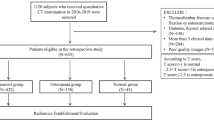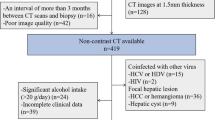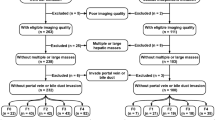Abstract
Background and Aims
Computed tomography (CT) provides scans of the human body from which digitized features can be extracted. The aim of this study was to examine the role of these digital biomarkers for predicting subsequent occurrence of hepatocellular carcinoma (HCC) in cirrhotic patients.
Methods
A cohort of 269 patients with cirrhosis were recruited and prospectively followed for the occurrence of HCC in Taiwan. CT scans were retrospectively retrieved and computationally processed using analytic morphomics. A predictive score was constructed using Cox regression and the generalized iterative modeling method, maximizing the log likelihood of the time to HCC development. An independent cohort of 274 patients from University of Michigan was utilized to examine the predictive validity of this score in a Western population.
Results
Of the 27 digitized features at the 12th thoracic vertebral level, six features were significantly associated with HCC occurrence. Two digitized features (fascia eccentricity and the bone mineral density) were able to stratify patients into high- and low-risk groups with distinct cumulative incidence of HCC in both the training and validation cohorts (P = 0.015 and 0.044, respectively). When the two digitized features were tested in the Michigan cohort, only bone mineral density remained an effective predictor.
Conclusion
Digitized features derived from the CT were effective in predicting subsequent occurrence of HCC in cirrhosis patients. The bone mineral density measured on CT was an effective predictor for patients in both Taiwan and USA.





Similar content being viewed by others
References
Ferlay J, Soerjomataram I, Dikshit R, et al. Cancer incidence and mortality worldwide: sources, methods and major patterns in GLOBOCAN 2012. Int J Cancer. 2014;136:E359–E386.
Huang T-S, Lin C-L, Shyu Y-C, et al. Diabetes, hepatocellular carcinoma, and mortality in hepatitis C-infected patients: a population-based cohort study. Journal of Gastroenterology and Hepatology. 2017;32:1355–1362.
Fattovich G, Stroffolini T, Zagni I, Donato F. Hepatocellular carcinoma in cirrhosis: incidence and risk factors. Gastroenterology. 2004;127:S35–S50.
Bruix J, Sherman M. Management of hepatocellular carcinoma. Hepatology. 2005;42:1208–1236.
Liaw Y-F, Kao J-H, Piratvisuth T, et al. Asian-Pacific consensus statement on the management of chronic hepatitis B: a 2012 update. Hepatol Int. 2012;6:531–561.
Lok ASF. Hepatitis B: liver fibrosis and hepatocellular carcinoma. Gastroentérol Clin Biol. 2009;33:911–915.
Yang H-I, Sherman M, Su J, et al. Nomograms for risk of hepatocellular carcinoma in patients with chronic hepatitis B virus infection. J Clin Oncol. 2010;28:2437–2444.
Lee M-H, Yang H-I, Liu J, et al. Prediction models of long-term cirrhosis and hepatocellular carcinoma risk in chronic hepatitis B patients: risk scores integrating host and virus profiles. Hepatology. 2013;58:546–554.
Yang H-I, Yuen M-F, Chan HL-Y, et al. Risk estimation for hepatocellular carcinoma in chronic hepatitis B (REACH-B): development and validation of a predictive score. Lancet Oncol. 2011;12:568–574.
Benjamin AJ, Buschmann MM, Schneider A, et al. Can comprehensive imaging analysis with analytic morphomics and geriatric assessment predict serious complications in patients undergoing pancreatic surgery? J Gastrointest Surg. 2017;21:1009–1016.
Crass RL, Ross BE, Derstine BA, et al. Measurement of skeletal muscle area improves estimation of aminoglycoside clearance across body size. Antimicrob Agents Chemother. 2018;62:e00441-18.
Cron DC, Noon KA, Cote DR, et al. Using analytic morphomics to describe body composition associated with post-kidney transplantation diabetes mellitus. Clin Transplant. 2017;31:e13040.
Derstine BA, Holcombe SA, Goulson RL, et al. quantifying sarcopenia reference values using lumbar and thoracic muscle areas in a healthy population. J Nutr Health Aging. 2018;22:180–185.
Derstine BA, Holcombe SA, Ross BE, Wang NC, Su GL, Wang SC. Skeletal muscle cutoff values for sarcopenia diagnosis using T10 to L5 measurements in a healthy US population. Sci Rep. 2018;8:11369.
Harbaugh C, Henderson B, Zhang P, et al. The ‘cushion effect’ is not protective for children involved in motor vehicle crashes. J Am Coll Surg. 2017;225:e187–e188.
Harbaugh CM, Zhang P, Henderson B, et al. Personalized medicine: enhancing our understanding of pediatric growth with analytic morphomics. J Pediatr Surg. 2017;52:837–842.
Harbaugh CM, Zhang P, Henderson B, et al. Evaluating the “cushion effect” among children in frontal motor vehicle crashes. J Pediatr Surg. 2018;53:1033–1036.
Heckman KM, Otemuyiwa B, Chenevert TL, et al. Validation of a DIXON-based fat quantification technique for the measurement of visceral fat using a CT-based reference standard. Abdom Radiol. 2019;44:346–354.
Holcombe SA, Hwang E, Derstine BA, Wang SC. Measuring rib cortical bone thickness and cross section from CT. Med Image Anal. 2018;49:27–34.
Holcombe SA, Wang SC, Grotberg JB. The effect of age and demographics on rib shape. J Anat. 2017;231:229–247.
Lee C, Raymond E, Derstine BA, et al. Morphomic malnutrition score: a standardized screening tool for severe malnutrition in adults. J Parenter Enter Nutr. 2018;42:1263–1271.
Miller AL, Englesbe MJ, Diehl KM, et al. Preoperative psoas muscle size predicts postoperative delirium in older adults undergoing surgery: a pilot cohort study. J Am Geriatr Soc. 2016;65:e23–e24.
Otemuyiwa B, Derstine BA, Zhang P, et al. Dorsal muscle attenuation may predict failure to respond to interleukin-2 therapy in metastatic renal cell carcinoma. Acad Radiol. 2017;24:1094–1100.
Parikh ND, Zhang P, Singal AG, et al. Body composition predicts survival in patients with hepatocellular carcinoma treated with transarterial chemoembolization. Cancer Res Treat. 2018;50:530–537.
Pienta MJ, Zhang P, Derstine BA, et al. Analytic morphomics predict outcomes after lung transplantation. Ann Thorac Surg. 2018;105:399–405.
Sharma P, Parikh ND, Yu J, et al. Bone mineral density predicts posttransplant survival among hepatocellular carcinoma liver transplant recipients. Liver Transplant. 2016;22:1092–1098.
Stidham RW, Waljee AK, Day NM, et al. Body fat composition assessment using analytic morphomics predicts infectious complications after bowel resection in Crohnʼs disease. Inflamm Bowel Dis. 2015;1:1306–1313.
Terjimanian MN, Underwood PW, Cron DC, et al. Morphometric age and survival following kidney transplantation. Clin Transplant. 2017;31:e13066.
Aberra FB, Essenmacher M, Fisher N, Volk ML. Quality improvement measures lead to higher surveillance rates for hepatocellular carcinoma in patients with cirrhosis. Dig Dis Sci. 2013;58:1157–1160. https://doi.org/10.1007/s10620-012-2461-4.
Huang Y-H, Liang K-H, Chien R-N, et al. A circulating MicroRNA signature capable of assessing the risk of hepatocellular carcinoma in cirrhotic patients. Sci Rep. 2017;7:523.
Liang K-H, Ahn SH, Lee HW, et al. A novel risk score for hepatocellular carcinoma in Asian cirrhotic patients: a multicentre prospective cohort study. Sci Rep. 2018;8:8608.
Konerman MA, Verma A, Zhao B, Singal AG, Lok AS, Parikh ND. Frequency and outcomes of abnormal imaging in patients with cirrhosis enrolled in a hepatocellular carcinoma surveillance program. Liver Transplant. 2019;25:369–379.
Santos LA, Romeiro FG. Diagnosis and management of cirrhosis-related osteoporosis. Biomed Res Int. 2016;2016:1423462.
Wu DB, Wang ML, Chen EQ, Tang H. New insights into the role of vitamin D in hepatocellular carcinoma. Expert Rev Gastroenterol Hepatol. 2018;12:287–294.
Miles LM. Food, nutrition, physical activity and the prevention of cancer: a global perspective—the WCRF/AICR second report. Nutr Bull. 2005;30:168–172.
Hann HW, Fu X, Myers RE, et al. Predictive value of alpha-fetoprotein in the long-term risk of developing hepatocellular carcinoma in patients with hepatitis B virus infection–results from a clinic-based longitudinal cohort. Eur J Cancer. 2012;48:2319–2327.
Acknowledgment
The authors would like to thank Brian Derstine, Brian Ross, Dr. Gigin Lin, Dr. Ching-Yi Hsieh, Wan-Ru Liang, Yi-Ting Liao, Yi-Wen Li, Chung-Yin Wu, Fang-Yi He, Hui-Chin Chen, Ya-Ming Cheng, Yu-Jean Chen, and Chien-Chih Wang of the liver research center for the excellent technical and administrative assistance.
Funding
PZ was partially supported by funding from the US National Institutes of Health (K01 DK106296). GLS was partially funded by U01 CA230669.
Author information
Authors and Affiliations
Corresponding author
Ethics declarations
Conflict of interest
SCW and the University of Michigan have a patent on the Morphomics Technique. SCW has equity interest in Applied Morphomics. No commercial funding was utilized for this project.
Additional information
Publisher's Note
Springer Nature remains neutral with regard to jurisdictional claims in published maps and institutional affiliations.
Electronic supplementary material
Below is the link to the electronic supplementary material.
Rights and permissions
About this article
Cite this article
Liang, KH., Zhang, P., Lin, CL. et al. Morphomic Signatures Derived from Computed Tomography Predict Hepatocellular Carcinoma Occurrence in Cirrhotic Patients. Dig Dis Sci 65, 2130–2139 (2020). https://doi.org/10.1007/s10620-019-05915-w
Received:
Accepted:
Published:
Issue Date:
DOI: https://doi.org/10.1007/s10620-019-05915-w




